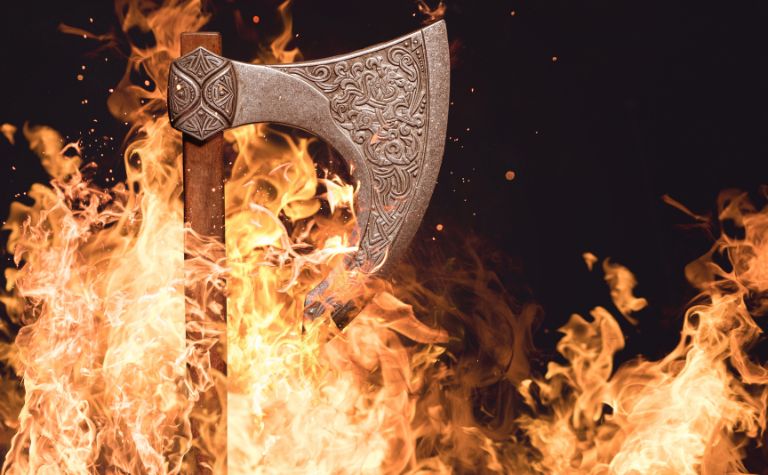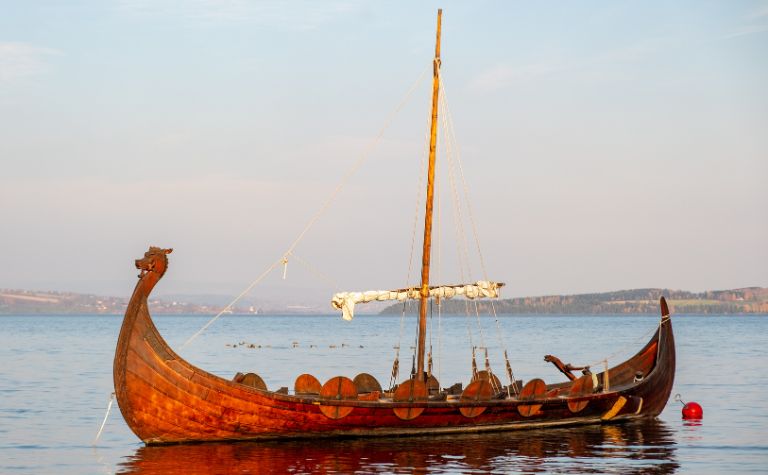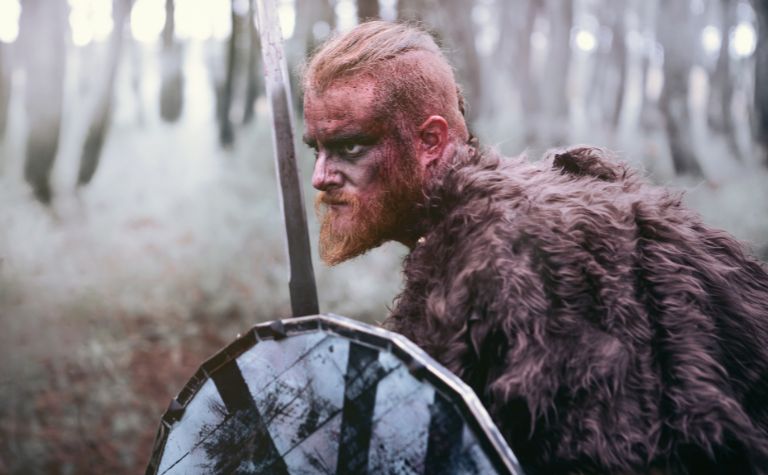War and weaponry were essential to Viking culture, and all free Norse men were expected to carry a weapon at all times.
The Vikings were also excellent artisans and were known to use several different types of weapons in battle.
The most commonly used weapon was the battle axe, as even the poorest men owned axes. [1]
The Vikings used two-handed axes called Danish axes, among other shorter axes which could be wielded single-handedly.
Two-handed axes are the most iconic of the axes used by the Vikings and the most commonly depicted in sculpture.
However, the Vikings prized axes for their versatility and used several different types of axes.
These axes were of different sizes and could be very simple or extremely ornate depending on their use and who they were.
Also, see Did the Vikings Make It to Africa? to learn more.

What Type of Axes Did Vikings Use?
The Vikings used axes for battles and as a tool for everyday use.
Unlike other weaponry, axes could be used for several purposes, although the Vikings also developed specialized battle axes.
The Vikings used short axes for cutting and splitting wood and throwing in battle, which would be fairly simple in their make.
Battle axes had larger heads and longer shafts, and these were of two types – the bearded axes and the larger Danish axes, which needed to be used two-handed.
The first type of Viking battle axe is known as a skeggox or bearded axe. [2]
This axe gets its name from the asymmetrical head, with the lower edge extending downwards.
The extension of the lower edge looked like a beard and was useful in extending the cutting surface and offering a hook to grab things with in battle.
The second type of Viking axe is the iconic broad axe, also known as the Danish axe.
Other names for this axe include the Dane axe, hafted axe, and English long axe.
This axe has a head that is narrow at the haft but flares out at both the top and bottom to form a wide, thin blade.
The Danish axe was large, used two-handed in close combat, and was usually sharp enough to behead a horse if swung with enough force.
The blades were forged to be as thin as possible to make the axe easy to wield in battle.
The axe also had an edge reinforced with hardened steel so it could cut through bone easily, making it devastating in combat.
Another type of axe used by the Vikings was the Mammen, which was shorter than the bearded or Danish axes.
The Mammen axe could be used easily in melee fights, close combat, and for throwing over long distances.
Typically, this type of short axe would have been used in conjunction with other weapons, especially a shield.
Shorter axes like the Mammen were convenient for use in battle as they could be used single-handed.
The warrior could then protect themselves with a shield. In contrast, when using a two-handed axe like the Danish axe, warriors would have to rely on luck and the men around them to protect them while they attacked.
Also, see What Is the Egtved Girl? to learn more.

What Did Viking Axes Really Look Like?
Viking axes ranged from simple to elaborate in their design. Shorter axes with small heads were used as both tools and weapons and tended to be simpler in their make.
In contrast, larger axes used solely for battle could be more ornate to represent the rank and status of the owner. [3]
Viking axes used in battle had large heads and shafts. The head of the bearded axe was asymmetrical, with the lower edge extending into a beard.
The Danish axe had a triangular blade forged to be thin and sharp. Among shorter axes, the Mammen axe was decorated with silver inlay.
Of Viking axes that have survived into the present day, only the blades have survived.
This is because the blades were typically made of iron, with copper, silver, and sometimes gold inlay decorations.
The axe hafts, on the other hand, were typically made of wood and haven’t survived over the years.
The Danish blade was typically around 6 – 8 inches (15 – 20 cm) in length. Historians assume that the larger blade would have required a longer haft.
Incomplete samples of the shaft of the smaller Mammen axe have also been found with some specimens.
Using sculptures, it’s been estimated that the axe was about 3 feet (1 meter) in length, though larger specimens also exist.
Also, see 11 Facts About Viking Longhouses to learn more.

Did Vikings Use Both Swords and Axes?
Viking Age sculptures offer a great deal of known information about military technology and advances of the time.
In the St. Andrews church in Pickering, a sculpture depicts Norse warriors surrounded by their weapons.
The Vikings used both swords and axes, though axes were more commonly used as they were versatile and affordable even for the poorest of men.
Apart from these, the Vikings also used a number of other weapons, including spears, shields, slings, bows, and arrows, and a type of dagger known as a seax.
Swords were a sign of high status among the Vikings as they were expensive to make and typically used by seasoned and wealthy warriors.
The average man would have to go on several raids to be able to afford a sword, and most warriors preferred to use axes or spears.
Nevertheless, the Vikings did use swords in battle, especially if they were high-ranking warriors. These swords would often have elaborately decorated hilts and scabbards, often in silver.
Viking swords were as practical as they were decorative. The blades themselves were forged using a method called pattern-welding.
Using pattern-welding, wrought iron and steel were welded together into a hardened edge for a weapon that could hold up better to the rigors of battle.
Swords were often passed on through generations, with older swords gaining value.
However, there is also precedence for swords being ‘killed’ in a ritual where the blades would be bent or broken.
This would make the sword unusable, effectively killing it so it could be buried with the warrior who had wielded it.
Conclusion
The Vikings used two-handed axes like the Danish axe in battle, although they also used shorter single-handed axes and various other weaponry.
Also, see Who Killed Lagertha In Vikings? to learn more.
